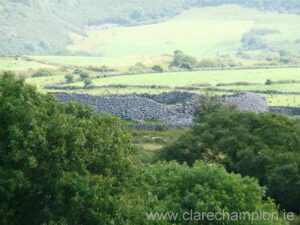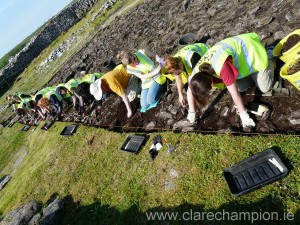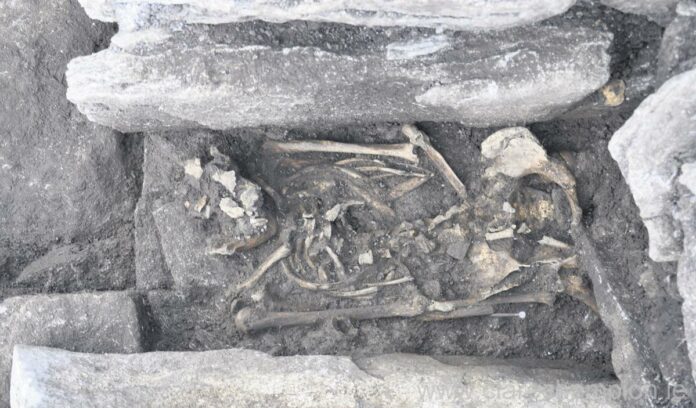EXCAVATIONS at Caherconnell are revealing some interesting practices undertaken by Ireland’s early Christians, according to Dr Michelle Comber, director of The Caherconnell Archaeological Field School at Carron.

Caherconnell cashel
“It is traditionally accepted that Christianity arrived in Ireland some time before the middle of the fifth century AD. You might be forgiven, then, for assuming that Christianity and Christian practices could be found throughout Ireland within a century or two of this date,” she said revealing that recent excavations by the Caherconnell Archaeology Field School are proving otherwise.
“It was discovered in the summer of 2013 that Caherconnell cashel or ‘caher’ (a circular drystone enclosure containing dwelling houses and other domestic structures) had been deliberately constructed over the top of an earlier burial mound. This small mound covered two limestone cists. Although disturbed at one end, their contents were still present. The smaller of the two cists contained the remains of a young child, between one and two years of age, and the bones of a baby who was either stillborn or died shortly after birth. The larger cist was only partially present inside the cashel, the rest of it being buried beneath the 3m-wide cashel wall. It contained the skeleton of a woman, at least 45 years of age. She suffered from joint disease, probably as a result of much physical labour over the course of her lifetime,” Dr Comber explained.
“The results of radiocarbon dating have just arrived, dating the human remains to 541-645 AD and 535-649 AD. This places them well within the chronological bounds of what was once termed ‘Early Christian Ireland’. Clearly, though, these people were not buried in a purely Christian fashion, rather in a mixture of traditional pagan and newer Christian burial practices. Following the Christian tradition, the bodies were unaccompanied by grave goods and were laid out almost east-west. They were not, however, interred in a Christian cemetery. Instead, they were placed in slab-built cists beneath a low stony mound. Such cists and mounds are commonly found in the pre-Christian prehistoric past. These people appear to have combined their traditional belief system with elements of the ‘new’ religion – hedging their bets maybe?,” she added.

“The story of these people does not end there. Several centuries after their deaths, in the 10th/11th century AD, the high status cashel settlement called Caherconnell (the caher or cashel of Conaill) was built at this location. The builders of this new home did not clear this mound and its contents out of their way, nor did they site their enclosure so as to avoid the mound. Instead, they built the drystone wall of their enclosure directly over the top of the mound, leaving approximately half of the mound intact and visible inside the new enclosure. It seems probable that knowledge of the mound and what it contained survived into the 10th/11th century AD, and that the new occupants of the spot deliberately incorporated these ancestors into their settlement. Was this, perhaps, an attempt to legitimize their rule of the area? Like the earlier burials themselves, this practice also has pre-Christian associations,” she said.
“It seems that being linked with the ancestors, whether by using the same burial method or by physically including them in your home, was a practice that survived the introduction and establishment of the Christian religion in Ireland. Some might say that an obsession with ancestors and where we come from is just as important to us today,” Dr Comber suggested.
This Summer the Caherconnell Archaeology Field School will excavate the centre of Caherconnell cashel.
“The main dwelling house is typically located in this part of the settlement enclosure. With almost 700 artefacts recovered from ‘open’ space inside the enclosure entrance, hopes are high for a very rewarding season this year,” Dr Comber concluded.
A native of Ennis, Colin McGann has been editor of The Clare Champion since August 2020. Former editor of The Clare People, he is a journalism and communications graduate of Dublin Institute of Technology.


